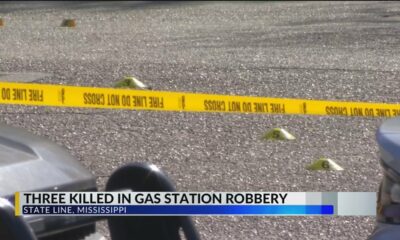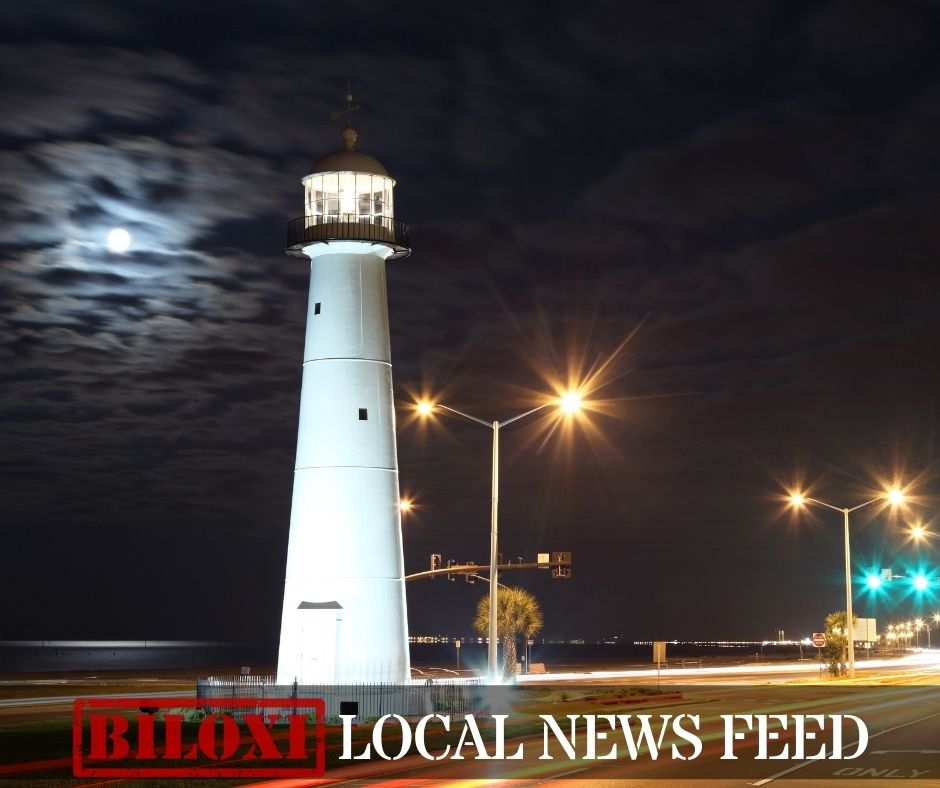Mississippi Today
First hypersonic weapon on a US warship being installed in Pascagoula

The U.S. Navy is transforming a costly flub into a potent weapon with the first shipborne hypersonic weapon, which is being retrofitted aboard the first of its three stealthy destroyers.
The USS Zumwalt is at a Mississippi shipyard where workers have installed missile tubes that replace twin turrets from a gun system that was never activated because it was too expensive. Once the system is complete, the Zumwalt will provide a platform for conducting fast, precision strikes from greater distances, adding to the usefulness of the warship.
“It was a costly blunder. But the Navy could take victory from the jaws of defeat here, and get some utility out of them by making them into a hypersonic platform,” said Bryan Clark, a defense analyst at the Hudson Institute.
The U.S. has had several types of hypersonic weapons in development for the past two decades, but recent tests by both Russia and China have added pressure to the U.S. military to hasten their production.
Hypersonic weapons travel beyond Mach 5, five times the speed of sound, with added maneuverability making them harder to shoot down.
Last year, The Washington Post reported that among the documents leaked by former Massachusetts Air National Guard member Jack Teixeira was a defense department briefing that confirmed China had recently tested an intermediate-range hypersonic weapon called the DF-27. While the Pentagon had previously acknowledged the weapon’s development, it had not recognized its testing.
One of the U.S. programs in development and planned for the Zumwalt is the “Conventional Prompt Strike.” It would launch like a ballistic missile and then release a hypersonic glide vehicle that would travel at speeds seven to eight times faster than the speed of sound before hitting the target. The weapon system is being developed jointly by the Navy and Army. Each of the Zumwalt-class destroyers would be equipped with four missile tubes, each with three of the missiles for a total of 12 hypersonic weapons per ship.
In choosing the Zumwalt, the Navy is attempting to add to the usefulness of a $7.5 billion warship that is considered by critics to be an expensive mistake despite serving as a test platform for multiple innovations.
The Zumwalt was envisioned as providing land-attack capability with an Advanced Gun System with rocket-assisted projectiles to open the way for Marines to charge ashore. But the system featuring 155 mm guns hidden in stealthy turrets was canceled because each of the rocket-assisted projectiles cost between $800,000 and $1 million.
Despite the stain on its reputation, the three Zumwalt-class destroyers remain the Navy’s most advanced surface warship in terms of new technologies. Those innovations include electric propulsion, an angular shape to minimize radar signature, an unconventional wave-piercing hull, automated fire and damage control and a composite deckhouse that hides radar and other sensors.
The Zumwalt arrived at the Huntington Ingalls Industries shipyard in Pascagoula, Mississippi, in August 2023 and was removed from the water for the complex work of integrating the new weapon system. It is due to be undocked this week in preparation for the next round of tests and its return to the fleet, shipyard spokeswoman Kimberly Aguillard said.
A U.S. hypersonic weapon was successfully tested over the summer and development of the missiles is continuing. The Navy wants to begin testing the system aboard the Zumwalt in 2027 or 2028, according to the Navy.
The U.S. weapon system will come at a steep price. It would cost nearly $18 billion to buy 300 of the weapons and maintain them over 20 years, according to the Congressional Budget Office.
Critics say there is too little bang for the buck.
“This particular missile costs more than a dozen tanks. All it gets you is a precise non-nuclear explosion, some place far far away. Is it really worth the money? The answer is most of the time the missile costs much more than any target you can destroy with it,” said Loren Thompson, a longtime military analyst in Washington, D.C.
But they provide the capability for Navy vessels to strike an enemy from a distance of thousands of kilometers — outside the range of most enemy weapons — and there is no effective defense against them, said retired Navy Rear Adm. Ray Spicer, CEO of the U.S. Naval Institute, an independent forum focusing on national security issues, and former commander of an aircraft carrier strike force.
Conventional missiles that cost less aren’t much of a bargain if they are unable to reach their targets, Spicer said, adding the U.S. military really has no choice but to pursue them.
“The adversary has them. We never want to be outdone,” he said.
The U.S. is accelerating development because hypersonics have been identified as vital to U.S. national security with “survivable and lethal capabilities,” said James Weber, principal director for hypersonics in the Office of the Assistant Secretary of Defense for Critical Technologies.
“Fielding new capabilities that are based on hypersonic technologies is a priority for the defense department to sustain and strengthen our integrated deterrence, and to build enduring advantages,” he said.
This article first appeared on Mississippi Today and is republished here under a Creative Commons license.![]()
Mississippi Today
Speaker White, Lt. Gov. Hosemann unveil tax cuts, other proposals as 2025 legislative session starts


Mississippi’s top legislative leaders on Monday unveiled details of their different plans to cut state taxes and potentially expand Medicaid coverage to the working poor, likely two of the main issues that will be debated at the Capitol over the next three months of the 2025 legislative session.
Republican Lt. Gov. Delbert Hosemann said he intends to push a proposal through the Senate to trim the state’s income and grocery taxes, while House Speaker Jason White wants to abolish the income tax altogether and slash the grocery tax in half.
Hosemann, the leader of the Senate, at a Monday Stennis Capitol Press Forum proposed immediately lowering the state’s 7% sales tax on grocery items to 5% and trimming the state’s 4% income tax down to 3% over the next four years.
Mississippi is already phasing in a major income tax cut. After rancorous debate in 2022, lawmakers agreed to a plan that will leave Mississippi with a flat 4% tax on income over $10,000, one of the lowest rates in the nation, by 2026.
Under Hosemann’s proposal, the income tax would be further reduced by .25% over the next four years and leave the state with a flat 3% income tax rate by 2030.
“I think continuing our elimination of the income tax, I think we can afford to do that over a period of time,” Hosemann said. “And we can still fund our transportation system and our education system.”
White, a Republican from West, said at a Monday press conference in his Capitol office that he wants to phase out the income tax completely over the next eight to 10 years and reduce the grocery tax from 7% to 3.5% over an unspecified number of years.
“I think it all needs to go, and I think you’ll see legislation from the House that does.” White said of the income tax. “Now, you’ll see legislation that makes it go in an orderly fashion over a period longer than four years.”
White said state economic growth, which averages 2% to 3% a year when measured over many years, would cover the tax cuts and elimination.
Mississippi has the highest tax on groceries in the nation, at 7%. The state collects the grocery tax along with all other sales taxes, but remits 18.5% back to cities. For many municipalities, the sales tax on groceries is a significant source of revenue.
Hosemann and White said separately on Monday that their plans to cut the grocery tax would include making municipalities whole. White said a potential way to do that is to allow towns and cities to enact additional sales taxes at the local level.
Another component of the first-term speaker’s tax plan is ensuring that the Mississippi Department of Transportation has a dedicated revenue stream available to fund new road infrastructure projects, which could include raising the state’s 18.4% gas tax, one of the lowest in the nation.
Any tax cut plan would go to Republican Gov. Tate Reeves’ desk for approval or rejection. Reeves has previously said his priority is eliminating the income tax, but he generally supports all types of tax cut packages as long as they do not raise any other tax.
Both want to tackle Medicaid Expansion again
White and Hosemann both said negotiations around Medicaid expansion could be delayed as legislative leaders wait to hear from a new Trump administration-led Centers for Medicare and Medicaid Services what changes might be coming down the pike, and whether the agency would approve a work requirement for Medicaid recipients.
“We’re going to pump the brakes and figure out where a Trump administration is on these issues,” White said. “Anybody that doesn’t want to do that, I think you’re not being honest with where the landscape is.”

Hosemann and Senate Medicaid Chair Kevin Blackwell, R-Southaven, have both told Mississippi Today they would not consider an expansion plan that didn’t include a work requirement.
Hosemann said Monday that he has already contacted CMS about the prospect of the federal agency approving a work requirement. But “like the army, the sergeant really runs the place,” Hosemann said, meaning the provision’s approval could rest in the hands of the agency’s future administrator.
President-elect Donald Trump has selected Dr. Mehmet Oz, a TV personality and celebrity physician, to be the administrator of CMS. Conservative think tanks and congressional Republicans have floated several potential changes to Medicaid, including slashing funding for the program and introducing federal legislation to bolster or require work requirements.
White said his caucus would continue to push for expansion despite possible cuts to the program.
“I just don’t think Congress and the Trump administration is going to go and try to find a way to try to kick 40 state’s people off of coverage for low income workers,” White said.
As the state continues conversations with CMS and waits for the U.S. Senate to confirm Oz, Hosemann expects the state Senate to introduce a “dummy bill,” or a placeholder containing only code sections required to expand Medicaid without approving specific details.
White expects the starting point for negotiations between the House and Senate will be a compromise bill both chambers appear to support before the proposal fizzled and died. The compromise proposal would have expanded Medicaid coverage to individuals who make roughly $20,000, or 138% of the federal poverty level, but only if the federal government signed off on a work requirement for recipients.
Opponents of the work requirement, including legislative Democrats, argue the bureaucracy of requiring monthly or semi-annual proof of employment further strains low-income people already facing a slew of socioeconomic barriers. Gov. Tate Reeves opposes expansion, and any expansion bill in 2025 will likely need the help of the minority party to achieve a veto-proof majority.
PERS, CON laws, sports betting among issues on table
Hosemann also said he plans to push for legislation that:
- Addresses chronic absenteeism in public schools
- Makes the Public Employees Retirement System financially sustainable
- Establishes last dollar tuition free community colleges
White also said he plans to advocate for bills that:
- Reform certificate of need laws to state medical centers
- Improve transparency around pharmacy benefit managers
- Restore suffrage to people previously convicted of nonviolent felony offenses
- Reinstate Mississippi’s ballot initiative process
- Legalize mobile sports betting
- Expands public education savings accounts for students located in D and F-rated school districts, putting the state’s portion of the students’ education funding into ESAs and allow the parents to use the money for allowable education expenses including private school tuition.
This article first appeared on Mississippi Today and is republished here under a Creative Commons license.![]()
Mississippi Today
Biden travels to New Orleans following the French Quarter attack that killed 14 and injured 30

WASHINGTON (AP) — President Joe Biden is taking a message to the grieving families of victims in the deadly New Year’s attack in New Orleans: “It takes time. You got to hang on.”
Biden on Monday will visit the city where an Army veteran drove a truck into revelers in the French Quarter, killing 14 and injuring 30 more. It’s likely to be the last time Biden travels to the scene of a horrific crime as president to console families of victims. He has less than two weeks left in office.
It’s a grim task that presidents perform, though not every leader has embraced the role with such intimacy as the 82-year-old Biden, who has experienced a lot of personal tragedy in his own life. His first wife and baby daughter died in a car accident in the early 1970s, and his eldest son, Beau, died of cancer in 2015.
“I’ve been there. There’s nothing you can really say to somebody that’s just had such a tragic loss,” Biden told reporters Sunday in a preview of his visit. “My message is going to be personal if I get to get them alone.”
Biden often takes the opportunity at such bleak occasions to speak behind closed doors with the families, offer up his personal phone number in case people want to talk later on and talk about grief in stark, personal terms.
The Democratic president will continue on to California following his stop in New Orleans. The White House was moving forward with plans for the trip even as a snowstorm was hitting the Washington region.
In New Orleans, the driver plowed into a crowd on the city’s famous Bourbon Street. Fourteen revelers were killed along with the driver. Shamsud-Din Jabbar, who steered his speeding truck around a barricade and plowed into the crowd, later was fatally shot in a firefight with police.
Jabbar, an American citizen from Texas, had posted five videos on his Facebook account in the hours before the attack in which he proclaimed his support for the Islamic State militant group and previewed the violence that he would soon unleash in the French Quarter.
Biden on Sunday pushed back against conspiracy theories surrounding the attack, and he urged New Orleans residents to ignore them.
“I spent literally 17, 18 hours with the intelligence community from the time this happened to establish exactly what happened, to establish beyond any reasonable doubt that New Orleans was the act of a single man who acted alone,” he said. “All this talk about conspiracies with other people, there’s not evidence of that — zero.”
The youngest victim was 18 years old, and the oldest was 63. Most victims were in their 20s. They came from Alabama, Louisiana, Mississippi, New York, New Jersey and Great Britain.
Louisiana Sen. Bill Cassidy, a Republican, was asked on Fox News Channel what the city was hoping for from Biden’s visit.
“How can we not feel for both the families of those who die but also those who’ve been injured in their families?” he asked.
“The best thing that the city, the state, and the federal government can do is do their best to make sure that this does not happen again. And what we can do as a people is to make sure that we don’t live our lives in fear or in terror — but live our lives bravely and with liberty, and then support those families however they need support.”
Associated Press writer Fatima Hussein contributed to this report.
This article first appeared on Mississippi Today and is republished here under a Creative Commons license.![]()
Mississippi Today
On this day in 2021


Jan. 6, 2021

Amanda Gorman was trying to finish her poem on national unity when scenes burst upon the television of insurrectionists attacking the U.S. Capitol.
The 22-year-old stayed up late, writing new lines into the night. Two weeks later, she became the youngest inaugural poet in U.S. history, joining a prestigious group that included Maya Angelou and Robert Frost. But few faced as difficult a task, searching for unity amid violence, a deadly pandemic and polarizing partisanship.
She described herself as a “skinny Black girl, descended from slaves and raised by a single mother” who can dream of being president one day, “only to find herself reciting for one.”
She shared the words she wrote in the wake of the nation’s first attack on the Capitol in more than two centuries:
“We’ve seen a force that would shatter our nation
rather than share it
Would destroy our country if it meant delaying democracy
And this effort very nearly succeeded
But while democracy can be periodically delayed
It can never be permanently defeated.”
In the wake of the attack that resulted in five deaths and injuries to 138 officers, she penned that the nation would endure:
Somehow we’ve weathered and witnessed
a nation that isn’t broken
but simply unfinished
She reminded those present that “history has its eyes on us” and that this nation will indeed rise again:
“We will rebuild, reconcile and recover
And every known nook of our nation and
Every corner called our country,
Our people diverse and beautiful will emerge,
Battered and beautiful…
For there is always light,
If only we’re brave enough to see it
If only we’re brave enough to be it”
This article first appeared on Mississippi Today and is republished here under a Creative Commons license.![]()
-

 News from the South - Florida News Feed6 days ago
News from the South - Florida News Feed6 days ago2025 opens with strong punch of cold air slated to send Florida into a freeze. Here’s what to expect
-

 Our Mississippi Home4 days ago
Our Mississippi Home4 days agoUSM Awards Honorary Degree to Renowned Country Music Songwriter
-

 Local News4 days ago
Local News4 days agoHow to catch the Quadrantids, the first meteor shower of 2025
-

 News from the South - Missouri News Feed4 days ago
News from the South - Missouri News Feed4 days agoFamily aims to open cannabis cultivation facility in North St. Louis • Missouri Independent
-

 SuperTalk FM5 days ago
SuperTalk FM5 days ago2 teens arrested for trying to carjack Hinds County reserve deputy
-

 News from the South - North Carolina News Feed5 days ago
News from the South - North Carolina News Feed5 days agoNorth Carolina Forecast: Cooler weather ahead with freezing lows through the weekend
-

 News from the South - Alabama News Feed5 days ago
News from the South - Alabama News Feed5 days agoFamily, officials speak out after 3 killed in Mississippi gas station robbery
-

 News from the South - North Carolina News Feed5 days ago
News from the South - North Carolina News Feed5 days agoConway falsely claims NC officials covering up storm deaths
































